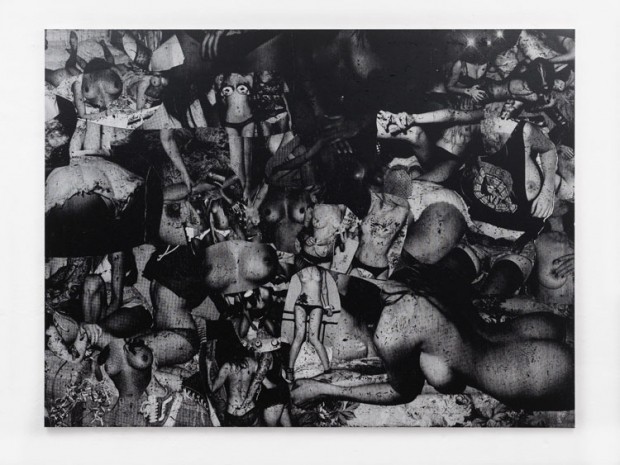Chris Succo
23 Apr - 23 May 2015
CHRIS SUCCO
Language of Elbow
23 April - 23 May 2015
At first glance, the black marks that run across the matte canvases of Chris Succo’s ZigZag Paintings almost appear to be writing—perhaps quick notes dashed off on a piece of scrap paper, or a notation system for something that isn’t self-evident.
When you look at a page of music notation, if you don’t read music, it might at first look like an abstraction. For most, notes on the page do not translate directly into a song, and even for the most skilled musicians, mathematical notations that denote loudness, emotion, and tempo are always subjective. Looking at the composition of the ZigZag Paintings, their gestural lines, kinetic compositions, and formal repetition conjure an unexpected music—one that requires no special knowledge to perceive.
Chris Succo’s Language Of Elbow, his first solo exhibition at Almine Rech, presents new iterations of two series of works—the aforementioned ZigZag Paintings and a series of untitled silkscreen paintings. Succo’s silkscreen paintings, made from images cut from magazines, pasted together, photographed, silkscreened, and then overworked with smudges of oil paint, suggest faded rock posters, or a cascade of images of a truant youth. Flirting with the history of the nude in painting, they are collages in impoverished grayscale, deadpan renderings of adolescent excesses glorified by rock ‘n’ roll.
Both series, created in a studio with a constant soundtrack, and titled with lines drawn from Succo’s own poetry, reverberate with energy and attitude. Together, they reflect on the act of painting in abstraction; in the context of their titles and Succo’s own history as a musician, are not unlike liner notes—on painting.
One painting, “Fire Your Guns”, obscures the characteristic composition of the ZigZag Paintings, joining together the ink blacks of the silkscreen works with the gestural abstractions of the rest of the series; its stenographic markings overset by a black foreground that effaces half of the painting. It could be a landscape, or a torn page. It evokes a terrain at the margins of poetry, painting, and music.
Alexander Shulan
Language of Elbow
23 April - 23 May 2015
At first glance, the black marks that run across the matte canvases of Chris Succo’s ZigZag Paintings almost appear to be writing—perhaps quick notes dashed off on a piece of scrap paper, or a notation system for something that isn’t self-evident.
When you look at a page of music notation, if you don’t read music, it might at first look like an abstraction. For most, notes on the page do not translate directly into a song, and even for the most skilled musicians, mathematical notations that denote loudness, emotion, and tempo are always subjective. Looking at the composition of the ZigZag Paintings, their gestural lines, kinetic compositions, and formal repetition conjure an unexpected music—one that requires no special knowledge to perceive.
Chris Succo’s Language Of Elbow, his first solo exhibition at Almine Rech, presents new iterations of two series of works—the aforementioned ZigZag Paintings and a series of untitled silkscreen paintings. Succo’s silkscreen paintings, made from images cut from magazines, pasted together, photographed, silkscreened, and then overworked with smudges of oil paint, suggest faded rock posters, or a cascade of images of a truant youth. Flirting with the history of the nude in painting, they are collages in impoverished grayscale, deadpan renderings of adolescent excesses glorified by rock ‘n’ roll.
Both series, created in a studio with a constant soundtrack, and titled with lines drawn from Succo’s own poetry, reverberate with energy and attitude. Together, they reflect on the act of painting in abstraction; in the context of their titles and Succo’s own history as a musician, are not unlike liner notes—on painting.
One painting, “Fire Your Guns”, obscures the characteristic composition of the ZigZag Paintings, joining together the ink blacks of the silkscreen works with the gestural abstractions of the rest of the series; its stenographic markings overset by a black foreground that effaces half of the painting. It could be a landscape, or a torn page. It evokes a terrain at the margins of poetry, painting, and music.
Alexander Shulan

